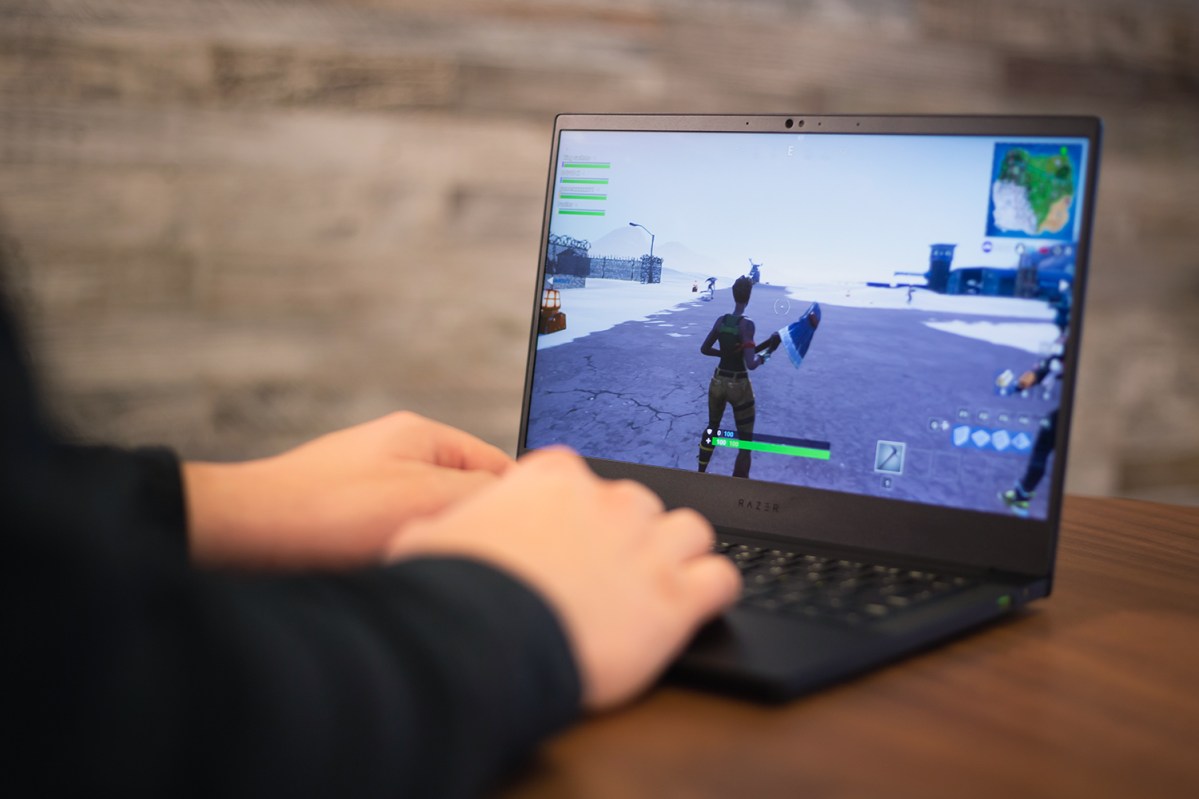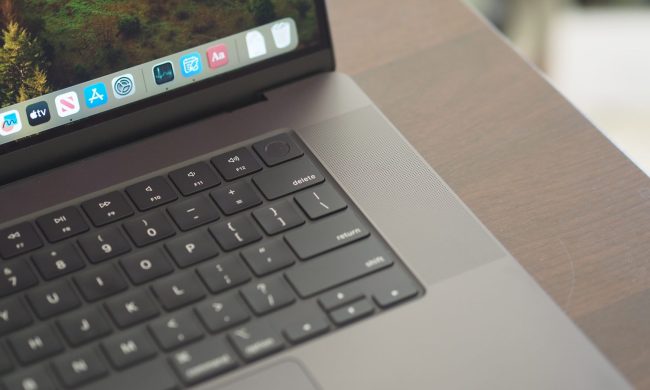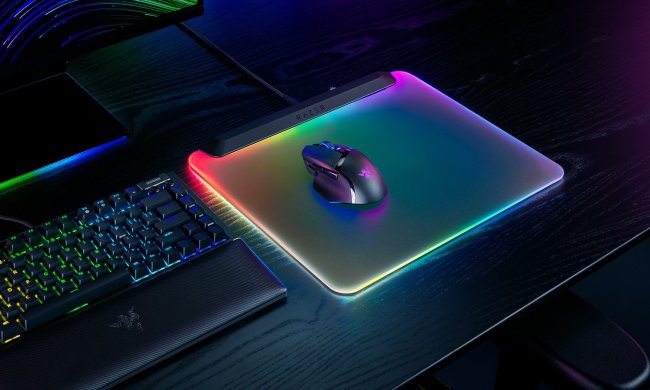“The Razer Blade Stealth looks incredible, but it’s focused more on portability than gaming performance.”
- Beautiful design
- Thin, light, and modern
- Discrete GPU is a welcome addition
- Impressive quad-core performance
- Spacious touchpad
- Mediocre battery life
- Gaming capabilities are still limited
The Razer Blade Stealth never had much to hide in the way of graphics capabilities. The 2019 Stealth changes that. With an optional 4GB MX150 graphics chip, the Stealth can now handle serious gaming without an external graphics dock — at least, that’s the hope.
The base model starts at $1,400. Adding Nvidia graphics ups that to $1,600. Regardless of which you choose, the Stealth picks up all the cutting-edge design traits of the 2018 Razer Blade gaming laptop, looking as modern and premium as ever.
But the competition is stiff, with laptops like the fantastic Dell XPS 13 and affordable Asus ZenBook 13 offering great alternatives for anyone. Any misstep can be a dealbreaker.
Boldly unbranded
The previous Razer Blade Stealth looked a little outdated when it came out earlier in the year. Today, it looks antique. The new version, however, is a complete redesign. The thick bezels are gone, along with the rounded edges, “spine” ridges on the lid, and generic silver finish. Instead, the new Stealth has been retrofitted to match the look of the 15-inch Razer Blade. That’s a good thing. A really good thing.
On looks alone, this is one of our favorite 13-inch laptops. MacBooks will always have their own untouchable polish, but these days, they’re not alone. The Dell XPS 13 is a gorgeous, unique- laptop, especially in its white-and-gold look. The Huawei MateBook X Pro has ultra-thin bezels and a slick polished aluminum finish.
The Razer Blade Stealth, though, has a refined simplicity we dig. It’s murdered out in jet black, even muting the green snake-head Razer logo on the lid. Somehow it does black in a way that looks edgy instead of making us think of a ThinkPad clone. In a world of flashy logos and Intel stickers, the Stealth’s unbranded look is bold.
Its built from a solid chunk of machined aluminum that doesn’t have a hint of flex, especially not in the keyboard deck and palm rests. There’s a little flex in the lid, which it shares with the Razer Blade gaming laptop, but it’s otherwise sturdy. The matte finish does pick up an ungodly amount of fingerprints, so be weary of greasy hands.
Related reviews
- Dell XPS 13 review
- Huawei MateBook X Pro review
- MacBook Pro 13-inch with Touch Bar review
- Asus ZenBook 13 review
On the inside, you’ll find a narrow display bezel that’s just 4.9mm on the sides. The top bezel, while slightly thicker, is large enough to house the laptop’s Windows Hello webcam. Each of these aspects look fantastic. Even the Chroma keyboard and enlarged touchpad are carried over from the Razer Blade, and it all looks fantastic.
As for ports, the Razer Blade Stealth is like the previous generation, with one exception. You lose the HDMI port and get a second USB-C port. Ideal port selection is often a matter of preference and use case, but for us, this mix of two USB-A and two USB-C is a nice balance of the old and the new. Some will miss the HDMI or SD card slot, but those are becoming less common by the day.
RGB for everyone
The Razer Blade Stealth inherits its keyboard design straight from the Razer Blade, and that’s a good thing. The travel on the keyboard is short, but we were able to adjust quickly and get right along to typing without much learning curve. Yet we do have one problem. The layout.
It’s cramped, with the keys along the edge becoming cut off. Worse, the Stealth borrows the worst aspect of the Razer Blade’s keyboard layout. The full-size up/down arrow keys. They’re a nice thing to have when it comes to gaming, but the up arrow key cuts between the Shift and Questions Mark keys. Trust us; it takes some getting used to.

The keyboard is powered by Chroma RGB backlighting, though it’s single-zone not per-key. Using the Razer Synapse app, it’s simple to get in and start customizing the lights to match your mood or current activity.
While keyboard is just ok, the touchpad is nearly perfect. It’s spacious, maximizing the space below the keyboard. The click isn’t overly loud, nor is it imprecise. It feels balanced in a way that few laptops are. Thanks to the Windows Precision drivers, it picks up multi-touch gestures and swipes well.
A bright, matte display
There are two options for screens on the Razer Blade Stealth: 1080p or 4K. We found our 1080p unit to be a high-quality matte panel with great viewing angles. But as screens continue to get better in laptops, a screen like this no longer stands out the way it may have a couple years ago.
The color gamut was good, but nowhere near a MacBook Pro. The same goes with contrast, where it’s decent but not fantastic, like the Huawei MateBook X Pro. The one area the Razer Blade Stealth impresses is brightness, which maxes out over 400 nits. That’s what we want to see in a premium laptop.
The Razer Blade Stealth also features a decent set of speakers. Thanks to their location on the keyboard deck, audio is crisp and loud. They don’t feature an extensive bass profile, but they’re a better set than most of competitors outside of MacBooks.
Whiskey Lake will leave you drunk with power
It may have taken a while for laptops to begin implementing Intel’s latest Whiskey Lake processors, but the wait was worth it. While not a huge leap forward, these new 8th-gen processors offer great performance. The Razer Blade Stealth has a Core i7, regardless of which configuration you choose.
According to Geekbench 4, we’re seeing increases in both single-core and multi-core performance compared to last year’s model, which is a great sign. It scored an 11 percent increase in single-core performance and an eight percent increase in multi-core.
We’re also seeing those improvements play out in real-life examples. It encoded a short video an entire minute faster than the previous Blade Stealth in Handbrake. That’s impressive. Our test unit also included an extra 8GB of RAM (for a total of 16GB), which helped a bit as well.
Razer also included super-fast memory in the Stealth, as the company is known to do. This time around, it’s the LiteOn CA3 M.2 SSD, which clocked in with read speeds of well over 2,000 MB/s, and write speeds of just under 1,000. Again, that’s an increase over the previous Stealth and at the front of the pack of its competitors. Our unit came with 256GB of capacity, and unfortunately, only the $1,900 4K model comes with additional storage. The RAM is soldered on, but you can replace the SSD yourself.
Don’t get too excited about gaming performance
Razer has talked up the gaming potential of this little system, most notably because of its option for a discrete GPU. Our unit came with the MX150, though a better version than you’ll find in other laptops like the Huawei MateBook X Pro or Asus ZenBook 13 UX331UN. This 25-watt, 4GB version supposedly provides some extra power for gaming performance.
The results, though, are not so convincing.
Don’t get us wrong. You’ll see a marginal improvement on the Stealth over those laptops. In 3DMark Fire Strike, it’s anywhere from 13 to 19 percent better, depending on the laptop. That’s not a bad improvement. However, in actual gameplay, it’s not night-and-day.
Titles like Civilization VI or Fortnite achieve get over 30 FPS (frames per second), as long as you turn settings down to Medium. They’re not smooth by any means, but they’re playable. Fast-paced shooters, however, are out of this laptop’s league. You’ll need to drop down to a lower resolution to make Battlefield 1 playable. The only game in our test suite the Stealth played smoothly was Rocket League, which managed to stay above 60 FPS with settings on High Quality. If lighter fare like Rocket League is more up your alley, the MX150 equips the Razer Blade Stealth with enough power to make it happen.

In other words, you can game on the Stealth, but the experience is limited. On top of that, Razer is charging a $200 premium for this graphics card. We’re just not sure it’s worth that. We’re happy Razer is experimenting with graphics on 13-inch laptops, but the dream of gaming on a compact, 13-inch laptop hasn’t arrived. If gaming is what you want to do, you can purchase the base model 15-inch Razer Blade, which comes with powerful GTX 1060 Max-Q graphics.
Alternatively, you could also plug an external GPUs. The Stealth was made to hand-in-hand with Razer’s own Core V2 or Core X, though there’s a rather large financial investment involved. You’ll have to pay at least $300 for the graphics dock, plus the price of a video card. At that point, you could buy a luxurious variant of the larger and more powerful Razer Blade.
If you want to stick with the Stealth, there’s another issue with the higher-watt card. Battery life.
The GPU is a power hog
Expectations for laptop battery life have increased significantly in the past year or so. Even by 2017’s standards, the Razer Blade Stealth’s battery life is a bit disappointing. Despite Razer’s claims of eleven hours of battery life, we saw closer to four or five hours in mixed usage. That’s not great.
In our battery tests, the Stealth falls behind its competitors significantly. In our video loop test, which loops a local 1080p clip at 100 lux until the battery dies, the Stealth lasted seven and a half hours. The Huawei MateBook X Pro, which has a higher-resolution screen and lower-powered MX150 GPU, lasted over four hours more. The XPS 13, meanwhile, can run for over thirteen and a half hours in video.
In our web-based battery tests, things looked even worse. The Stealth’s battery died in under five hours. Basemark, our most intensive battery test, died in two hours and 48 minutes. The MateBook X Pro, again, will go for a solid two hours more. These numbers are all worse than the previous Blade Stealth, even though Intel’s new processors are supposed to be more efficient, not less. So, what’s going on here?
The new Stealth uses the same 53 watt-hour battery the previous version did, and that’s the same size battery used in both the base model and graphics model. The problem, then, has to be the MX150. The laptop uses Nvidia Optimus technology to switch over to the integrated graphics when the MX150 isn’t being used, which should have helped with battery life, but it’s not able to manage power consumption well enough. Razer tells us the GPU still causes a slight power draw, even when it’s not in use.
What about the base model without the discrete graphics? Though we haven’t tested it, you should expect a couple more hours of battery life, which edges the Stealth into the acceptable range for a premium 13-inch laptop.
Our Take
At first glance, the Razer Blade Stealth is a dream-come-true laptop. No laptop manufacturer has bolstered its design cred quite like Razer, and the new Stealth is only more of that goodness. Unfortunately, poor battery life and limited gaming performance make the “graphics” model a hard sell at $1,600. The base model is a bit less interesting, but it’s a much better purchase, and a significant upgrade over last year’s model.
Are there any alternatives?
There are dozens of great 13-inch laptops, but the best is still the Dell XPS 13. Not only is it hundreds of dollars cheaper, it also has better performance and significantly better battery life.
If you’re looking for something with a similar GPU, the Huawei MateBook X Pro is a good alternative. It’s just as sleek, offers better battery life, and even includes a touchscreen. The 10-watt GPU isn’t quite as good, but it’s certainly better than nothing.
Lastly, we’d recommend considering the base model 15-inch Razer Blade as an alternative to the “graphics” model Blade Stealth. It costs the same amount, while offering significantly better performance with its GTX 1060 Max-Q graphics card. It’s not even that large, thanks to improvements in the newest model.
How long will it last?
The Razer Blade Stealth is a well-constructed, futureproofed laptop. It should last you at least a few years, possibly more. The laptop comes with a one-year limited warranty, which is standard.
Should you buy it?
No, at least not the “graphics” model we tested. The base model, however, is another story. You’ll pay extra for Razer’s signature design, but it’s worth it.








